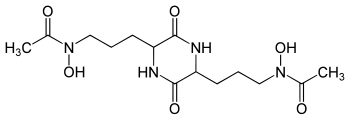Hydroxamic acid

A hydroxamic acid is a class of organic compounds bearing the functional group RC(O)N(OH)R', with R and R' as organic residues and CO as a carbonyl group. They are amides (RC(O)NHR') wherein the NH center has been replaced by an OH. They are often used as metal chelators.
Synthesis and reactions
Hydroxamic acids are prepared usually from esters or acid chlorides or carboxylic acids. For the synthesis of benzohydroxamic acid, the overall equations is:[1]
- C6H5CO2Me + NH2OH → C6H5C(O)NHOH + MeOH
Hydroxamic acids can also be synthesized from aldehydes via the Angeli-Rimini reaction.
A well-known hydroxamic acid reaction is the Lossen rearrangement.
Coordination chemistry and biochemistry
- Sample gallery
-

Deferoxamine
In the area of coordination chemistry, hydroxamic acids are excellent ligands.[2] They deprotonate to give hydroxamates, which bind to metals ions as bidentate ligands. So high is the affinity of hydroxamates for ferric ions that nature has evolved families of hydroxamic acids to function as iron-binding compounds (siderophores) in bacteria. They dissolve insoluble iron(III) compounds. The resulting complexes are transported into the cell, where the iron is extracted and utilized metabolically.[3]
Other uses and occurrences
Hydroxamic acids are used extensively in floatation of rare earth minerals during the concentration and extraction of ores to be subjected to further processing.
Some hydroxamic acids (e.g. vorinostat, belinostat, panobinostat, and trichostatin A) are HDAC inhibitors with anti-cancer properties. Fosmidomycin is a natural hydroxamic acid inhibitor of 1-deoxy-D-xylulose-5-phosphate reductoisomerase (DXP reductoisomerase). Hydroxamic acids have also been investigated for reprocessing of irradiated fuel.
References
- ↑ C. R. Hauser and W. B. Renfrow, Jr "Benzohydroxamic Acid" Org. Synth. 1939, volume 19, p. 15ff.
- ↑ Agrawal, Y K (1979). "Hydroxamic Acids and Their Metal Complexes". Russian Chemical Reviews 48 (10): 948. doi:10.1070/RC1979v048n10ABEH002422.
- ↑ Miller, Marvin J. (November 1989). "Syntheses and Therapeutic Potential of Hydroxamic Acid Based Siderophores and Analogues". Chemical Reviews 89 (7): 1563–1579. doi:10.1021/cr00097a011.
Additional reading
- Fouché, K. F.; H. J. le Roux; F. Phillips (June 1970). "Complex formation of Zr(IV) and Hf(IV) with hydroxamic acids in acidic solutions". Journal of Inorganic and Nuclear Chemistry 32 (6): 1949–1962. doi:10.1016/0022-1902(70)80604-2. ISSN 0022-1902. Retrieved 2009-04-24.
- Barocas, A.; F. Baroncelli; G. B. Biondi; G. Grossi (December 1966). "The complexing power of hydroxamic acids and its effect on behaviour of organic extractants in the reprocessing of irradiated fuels--II : The complexes between benzohydroxamic acid and thorium, uranium (IV) and plutonium (IV)". Journal of Inorganic and Nuclear Chemistry 28 (12): 2961–2967. doi:10.1016/0022-1902(66)80023-4. ISSN 0022-1902. Retrieved 2009-04-24.
- Baroncelli, F.; G. Grossi (May 1965). "The complexing power of hydroxamic acids and its effect on the behaviour of organic extractants in the reprocessing of irradiated fuels--I the complexes between benzohydroxamic acid and zirconium, iron (III) and uranium (VI)". Journal of Inorganic and Nuclear Chemistry 27 (5): 1085–1092. doi:10.1016/0022-1902(65)80420-1. ISSN 0022-1902. Retrieved 2009-04-24.
- Al-Jarrah, R. H.; A. R. Al-Karaghouli; S. A. Al-Assaf; N. H. Shamon (1981). "Solvent extraction of uranium and some other metal ions with 2-N-butyl-2-ethyl octanohydroxamic acid". Journal of Inorganic and Nuclear Chemistry 43 (11): 2971–2973. doi:10.1016/0022-1902(81)80652-5. ISSN 0022-1902. Retrieved 2009-04-24.
- Gopalan, Aravamudan S.; Vincent J. Huber; Orhan Zincircioglu; Paul H. Smith (1992). "Novel tetrahydroxamate chelators for actinide complexation: synthesis and binding studies". Journal of the Chemical Society, Chemical Communications (17): 1266–1268. doi:10.1039/C39920001266.
- Koshti, Nirmal; Vincent Huber; Paul Smith; Aravamudan S. Gopalan (1994-02-28). "Design and synthesis of actinide specific chelators: Synthesis of new cyclam tetrahydroxamate (CYTROX) and cyclam tetraacetonylacetone (CYTAC) chelators". Tetrahedron 50 (9): 2657–2664. doi:10.1016/S0040-4020(01)86981-7. ISSN 0040-4020. Retrieved 2009-04-30.

